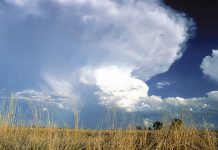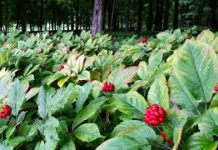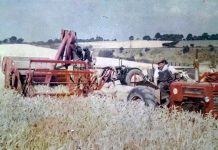Salt affected soils are soils that contain either enough soluble salts to impair crop growth – called saline soils, or enough sodium to impair crop growth and affect the physical quality of soil – called sodic soils.
There are different types of salt affected soils,†says Dr. Ross McKenzie, PhD, P. Ag., senior research scientist – agronomy, with Alberta Agriculture and Rural Development. “Saline soils are easy to recognize when you see white patches in fields, those have a fairly high concentration of soluble salts which can interfere with plant growth. The other type of salt affected soils found in Alberta are sodic soils. These soils are very high in sodium and they do not demonstrate white patching, if anything the soil will have a black sheen, making it difficult to visually identify sodic soils. Saline sodic soils are common salt affected soil problems, especially in southern Alberta. Sodic soils, which are classified as Solonetzic soils, occur throughout Alberta.â€
The first hint that producers may get that their soils could be adversely affected by salt affected are when crops aren’t growing well in patches or specific areas. The only true way to determine if the soil is saline is to take a soil sample of surface soil in to a lab and have them check for the electrical conductivity (EC) of the soil extract.
“When the EC levels are greater than 2.0 deciSiemens per metre (2 dS/m), then salt levels start to become a concern and the growth of some crops would be impaired,†says McKenzie. “Soil pH is usually near neutral to moderately alkaline, so if the EC goes over 2, if growing a bean crop, the yield loss can be upwards of 30 per cent.â€
By the time white salts are observed on the soil surface, the level are usually greater than 10 dS/m. Once white salts can be seen, the vast majority of the yield potential will be lost.
Soluble salts occur naturally in many subsoils and bedrock deposits throughout Alberta. Groundwater flowing through these deposits dissolve and transport the salts as the groundwater moves laterally over bedrock or impermeable soil layers. Under certain conditions, such as summerfallowing land or over irrigation, the groundwater level will increase and in lower topographic areas will move by capillery rise to near the soil surface. As the water is used by crops or evaporates, the soluble salts that were transported by the groundwater are left behind. Over a period of many years, the salts accumulate in the surface soil. Initially crop growth is better as plants have access to more water, and crop yields are improved. However, gradually over a period of years, the salt concentration in soil increases and crop growth and yield are reduced. Eventually, when the salt concentration is very high, a white salt crust forms on the soil surface. When visible white salts occur, only very salt-tolerant plants grow in saline areas. The land around the visibly saline area will also have saline subsoil, resulting in reduced crop yields.
In situations where soil salinity occurs naturally, those soils cannot be reclaimed. In other situations, referred to as secondary salinity causes by agricultural activities, excess water causes the salinity, if the causes can be determined such as summerfallow practices or a seeping irrigation canal, the solution is to reduce or stop the source of excess water entering into the groundwater. These areas are called recharge areas as they are the source of excess water being recharged into the groundwater. The area where the salts are accumulating is referred to as the discharge area as this is where the salts are being deposited. In the situation of a dugout or seeping irrigation canal, lining the canal or dugout to prevent the loss of water is the first step. In dryland areas, if the source of excess water is the result of summerfallowed fields, farmers would need to adopt different cropping practices. Fields could be continuously cropped and specific areas might even need to be seeded to deep-rooted alfalfa to prevent deep percolation of water.
“In saline areas, if salinity is only moderate, a farmer could try to establish alfalfa to start to draw down the high water table,†says McKenzie. “However, if the soil is severely saline, a salt tolerant grass mixture should be seeded and established. These measures, once put into practice, will take a number of years to gradually reclaim the saline area to the point where they will be productive again.
Source: http://www.thecropsite.com
Related articles
- How to Maintain Good Crop Yields Without Using Pesticides (expertscolumn.com)
- Battling climate change with tried-and-true methods (phys.org)




